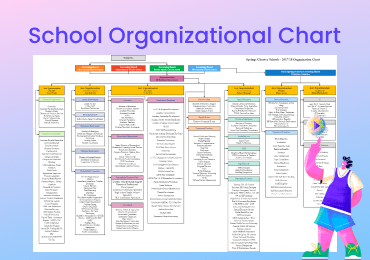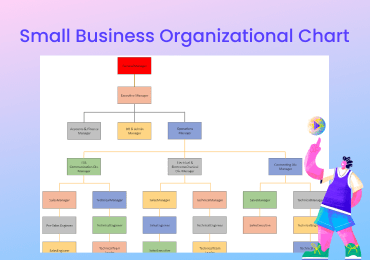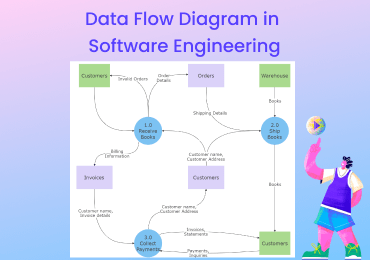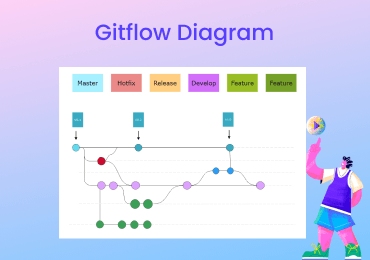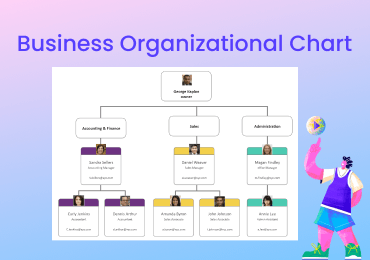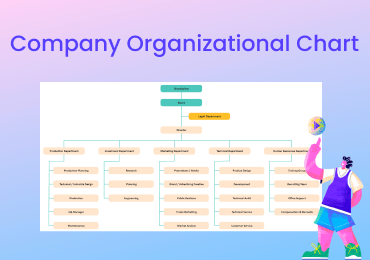What is Business Process Model and Notation (BPMN)?
This article will introduce business process modeling (BPMN), a technique to document a business process and discuss its scope in various fields and essential steps to creating a BPMN diagram.
1. What is BPMN?
As the name suggests, BPMN is graphical modeling of business processes from start to end, along with the set notations. It operates to work on the flowchart technique that is much similar to Unified Modeling Language and activity diagrams. The set standards of Business Process Diagrams in BPMN help you to understand the procedures of internal business transactions and performance collaborations via graphical notations. The BPMN diagramis a handy technique to ease out the mapping processes with standard symbols.
To improve the business processes, the knowledge of Business Process Modeling and Notation as a subset of BPM (Business Process Management) is a must.
Hence, this article is determined to help you know about the BPMN and the capable software for drawing BPMN diagrams. So, let’s get started on an informative journey.

2. History of BPMN
The history of BPMN lay with another name when it was first developed in 2000 by BPMI (Business Process Management Initiative). BPMI is a non-profit organization concerned mainly with the origin of BPMN. In 2005, the BPMI group got merged with Object Management Group (OMG), which took steps to update BPMN from time to time.
The recent up-gradation is BPMN 2.0 with specific standards and various types of maps for representing the work processes of modern and real organizations. Now, the method name of Business Process Modeling Notation 2.0 is Business Process Model and Notation. It has also been complemented to be known as the Decision Model, and Notation standard since 2014 as the BPMN doesn’t lend itself naturally to decision flows.
3. Purposes and Benefits of BPMN
A BPMN diagram is a visual representation consisted of easy to understand steps. When you are fully aware of Business Process Model and Notation, let's look into its benefits and the scope or the purpose of using this diagram.
3.1 Purposes of BPMN
The business process modeling represents a business process that can be public or private. The scope of BPMN is that it is used to help to bridge the communication gaps that exist in an organization, especially those with multiple departments. At a broader level, the purpose of the Business process modeling notation is to target all the stakeholders involved in the business process activity to gain insight using the visual representation of the process. It is beneficial for those implementing the process on the ground level.
The BPMN provides a straightforward language for all the participants (Management, technicians, analysts, external team, etc.) of the activity or process. It helps unite them on one platform, everyone being aware of their duty, squeezing out the inefficiencies, identifying the crucial deadlines, and eliminating the overlapping tasks and unnecessary steps.
3.2 Benefits of BPMN
The stakeholders dependent on understanding the business process will get huge benefits while going through the business process diagrams. It will let them make effective decisions and precise implementation through the presented business procedures and their sufficient details.
Since BPMN is inclusive of a common and standard language, it is useful for all kinds of stakeholders, including business analysts, technical or non-technical developers, process participants, and managers, etc.
Here are some benefits that will help you understand the need for BPMN diagrams.
- Relying on intricate workflow diagrams may be a hectic task when it comes to defining the business processes. In this case, only a BPMN diagram can help you out and make to look the process much simpler.
- A BPMN diagram beautifully bridges the gap between the process implementation and the process intention by offering relevant details and clarity about the following business activities.
- Typically, the large organizations mandatorily follow the concept of Business Process Management which requires using the standardized business modeling tools and completing the formal modeling and notation needs.
4. BPMN Notation
Now, we are going to introduce BPMN 2.0 elements and symbols for business process diagrams. These main elements are as follows.
- Flow Objects: Activities, Events, and Gateways
- Connecting Objects: Message Flow, Sequence Flow, and Association
- Swimlanes: Pool or Lane
- Artifacts: Group, Data Object, and Annotation
Let’s see the description of each element in the following section.
4.1 Activities
Activities denote the tasks to be performed by a business process. They are simple and represented with a rounded corner rectangular shapes. The symbol of activity represents the work to be done, an item on a to-do list, or a checkbox on the checklist. To make them detailed, you can add sub-processes, loops, compensation, and multiple instances.

4.2 Events
The BPMN Model start and end with different symbols of events. An event refers to the happening of something, unlike an activity or task. The primary logo is a circle, and the icons are inserted within this circle to denote what is happening. For instance, there is an event of receiving or sending a message indicated via terms ‘catching’ and ‘throwing.’ The different types of events include the timer, message, error, signal, compensation, cancel, link, escalation, and so on.
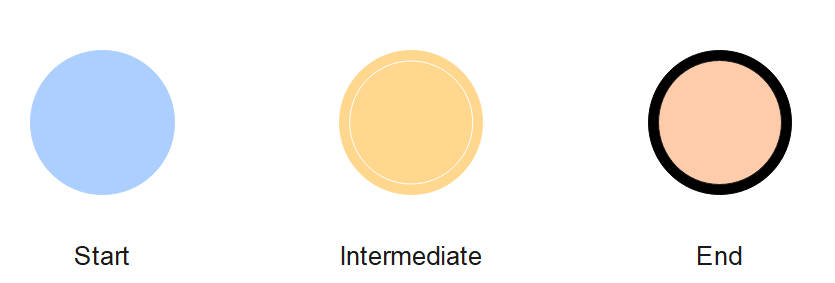
4.3 Gateways
The symbols get indicated by diamonds and are a conditional element. They are a kind of decision point to adjust paths based on different events and conditions. Various types of gateways include exclusive, inclusive, event-based, and parallel gateways.
- An exclusive gateway represents only one option with the movement of workflow from one route to another.
- The event-based gateways are dependent on other tasks that happen.
- The parallel gateways denote two side by side paths that aren’t dependent on each other.

4.4 Message Flow
Being represented by a dashed line with a circle at the start and an arrow at the end, message flow is a symbol to be used across pools or lanes to send information (not a strict action). It is the way to get work done in different organizations or departments.
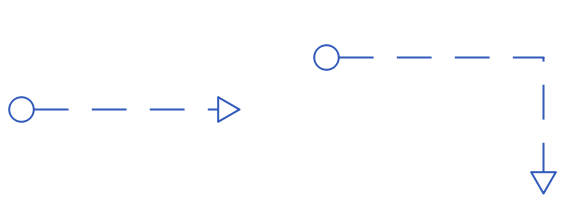
4.5 Sequence Flow
It is a symbol used to represent the pure flow of work. The sequence flow is necessary to connect different activities and show their order through a straight line ending with an arrow. It may sometimes show a default or conditional discharge.
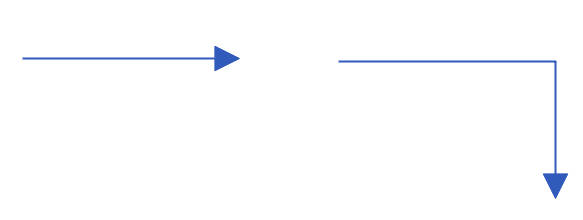
4.6 Association
Association The element of association is for tying the documents, artifacts, and databases with the activities. It is a dotted line used to link the event or text to a business or gateway.
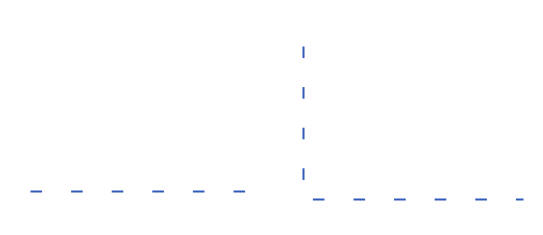
4.7 Pool
The most significant units on a BPMN diagram map are known as pools. These areas include events, lanes, and tasks, etc. Pools represent who is doing the job. They indicate the whole workflow upon which different business processes are getting done. Pools show participants such as companies, departments, or companies.
4.8 Lanes
The most prominent element of the pool gets further divided into rows or lanes. Lane represents one parallel within the process and shows both responsibilities as well as the tasks of each department. However, lanes don’t mean people or departments every time. They can also be general roles or specific positions in different organizations.
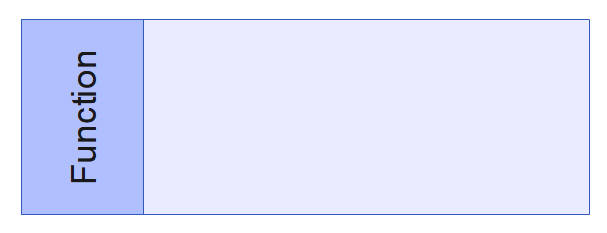
4.9 Artifacts
Artifacts are additional information that developers provide to enhance the details of a BPMN diagram. It includes three types namely, the group, data object, and annotation. A group is a logical formation and grouping of activities that does not change any of the diagram’s flow. A data object shows the necessary data for an operation. An annotation is an additional explanation to a part of the BPMN diagram.

5. BPMN Examples and Use Cases
Let's explore some of the examples of BPMN to understand the steps better, working and features of the diagram.
Example 1: Business
This example has provided the general overview of the steps involved in business activity, from the procurement of the raw materials to manufacture a product to the after-sales customer services for that product. Here, the enterprise acquires the raw material from its vendor then sends it to the manufacturing plant, where the plant workers convert it into a finished product.
Then comes the task of the packaging and inventory team, after which the product is sent to the distribution team, where the end product is delivered to the customer through delivery men. Besides this, the marketing team is also running campaigns to increase sales of the product, and in the end, comes the duty of the customer service team to provide after-sales services.
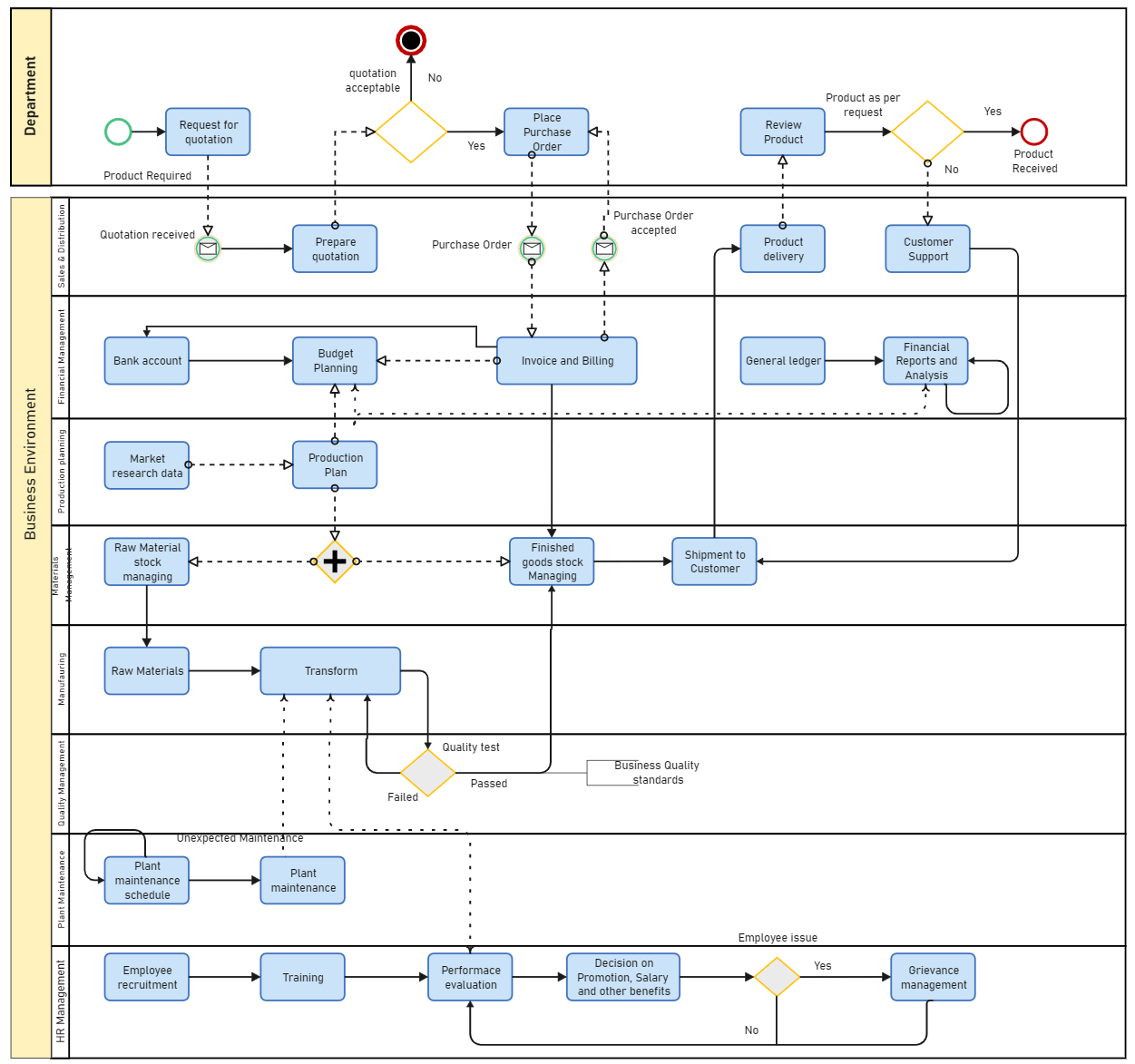
Example 2: IT
Let's look into the modeling process of the software module testing; here, a visual representation of the evaluation or testing of a single module in an extensive system is shown. The software is examined, and the test data is in the configuration control.
The diagram depicts the participants involved in testing the process, its inputs and outputs, and pre and post-conditions. The engineer tries the module and looks into its preconditions; then, after running the test process, improvement is being made, after which the desired output is achieved.
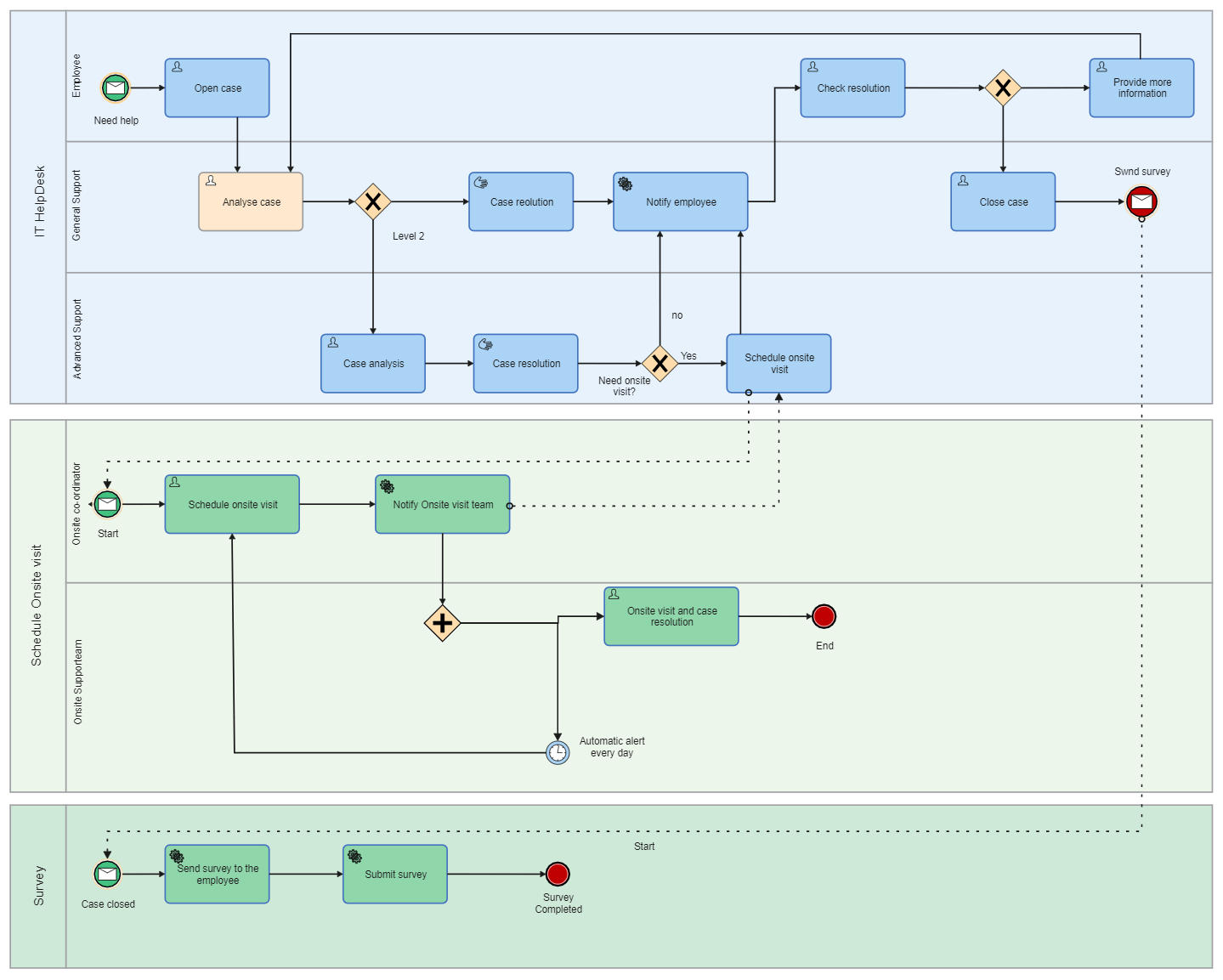
Example 3: Marketing
The Star is the leading product/service of any company with high market growth and high market share, and these products are mainly launched recently. The Boston consultant group approach is widely used in the marketing process, and it's one of the essential tools to analyze and evaluate a company's product or services portfolio. The diagram is composed of two dimensions and four quadrants.
The Cash cows were once the Star product/service; by the time, it's now converted into the cash cow because of its sustainable competitive advantage. The cash cows are the leading product/service for any company as they generate a significant portion of its revenue.
The Question marks are the product/service with the high market growth and low share. The Dogs are the product/service with low market growth and share, and the marketers often think to eliminate them from their portfolios or sell them to another company. The marketers took steps to convert them into a star product.
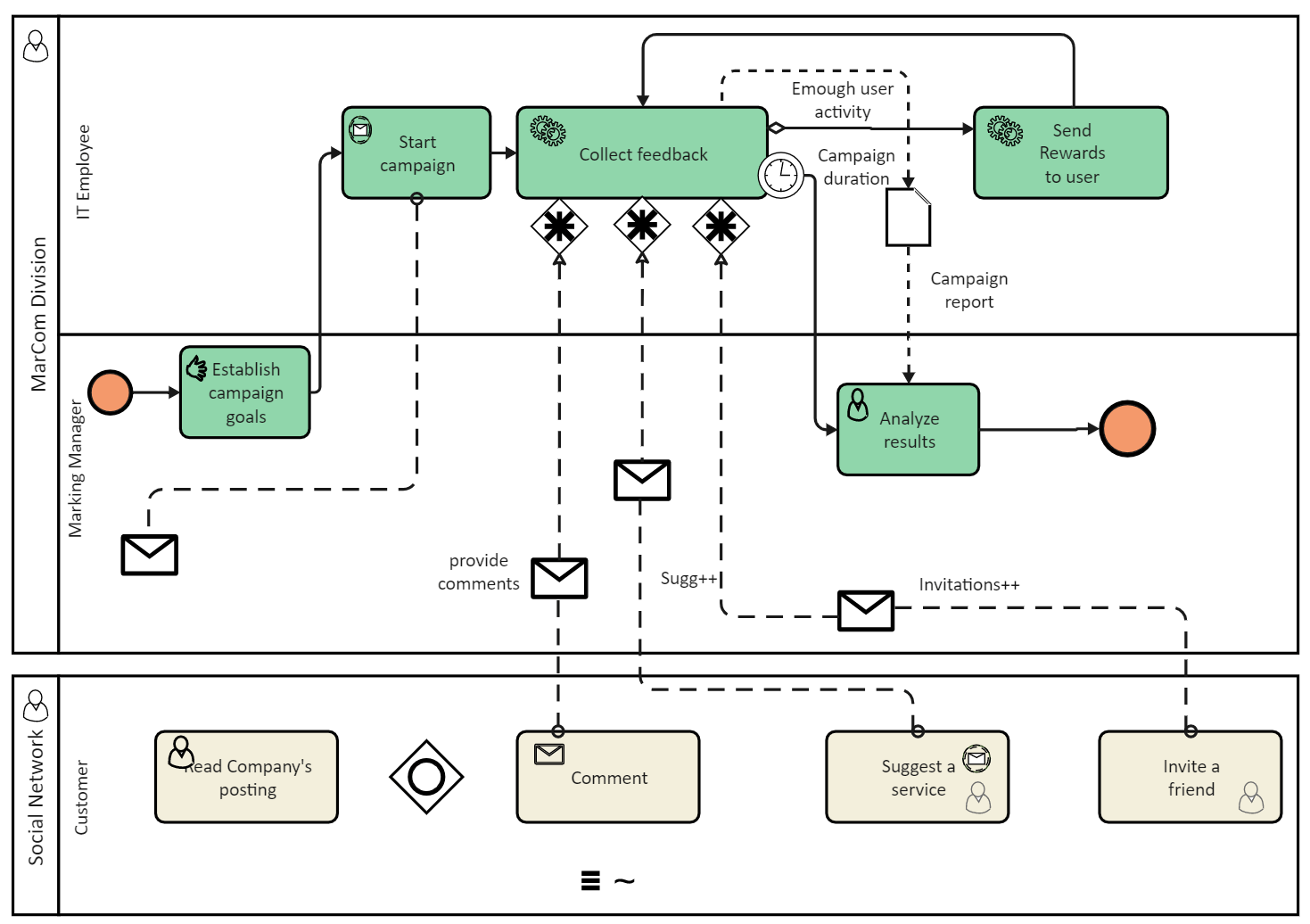
Example 4: Food
Food mapping is an excellent technique for health and diet-conscious individuals; here, you can see that a complete weekly diet plan of a person is shown; its main course includes pasta, fish, and pizza. For nutrients like potassium, fiber, folate, and Vitamin A and C, vegetables are included in the diet.
Food maps help and give a complete guide of what to consume in what quantity and on what day or date. The Drinks include tea, juice, water, coffee, and multiple deserts in the food map. Buffett restaurants also use food mapping to showcase what value they provide or what dishes are included in their menu.
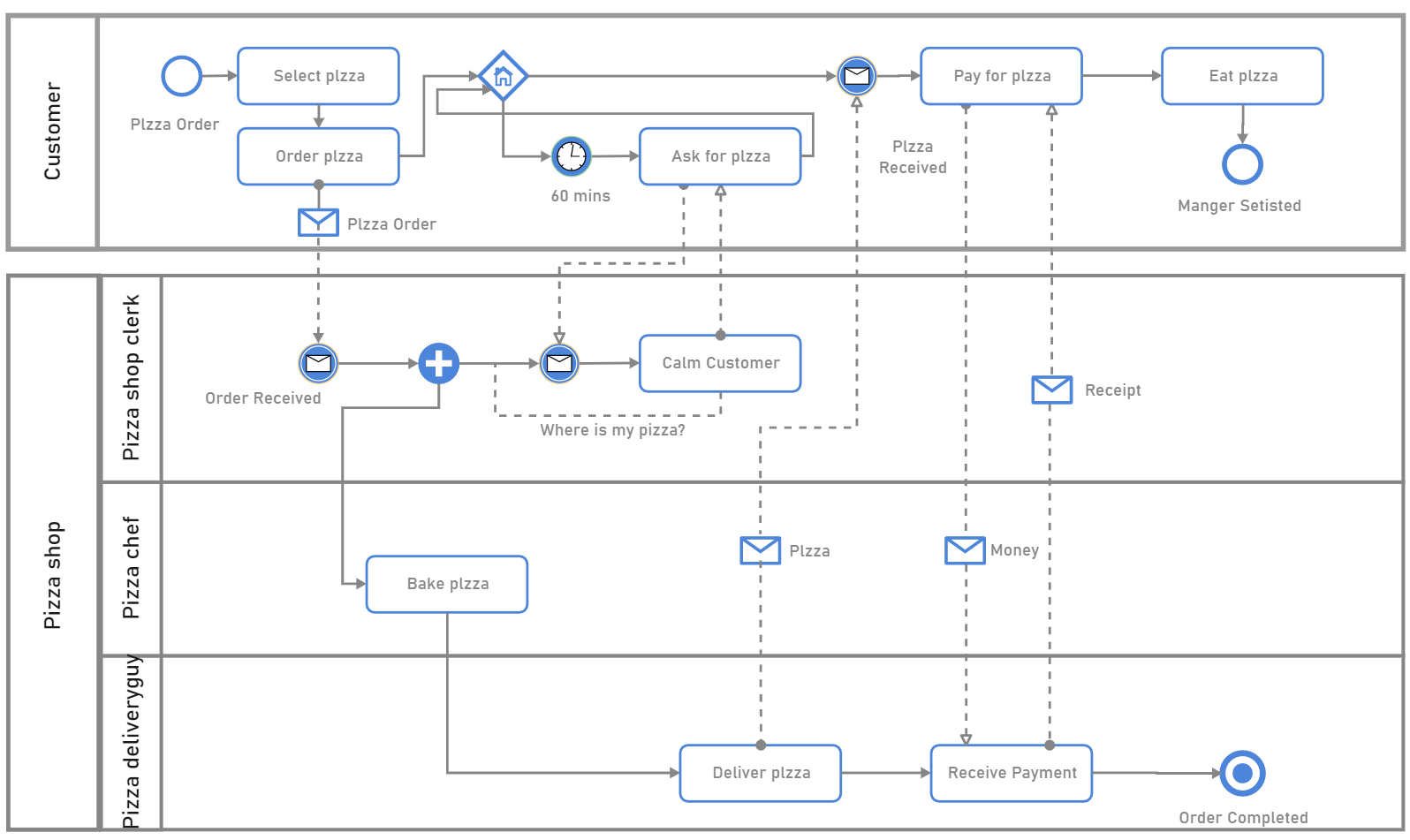
Example 5: Medical
It is an excellent example of medical service process modeling here; four participants are involved in the activity, the patient, receptionist, Nurse, and the Doctor. Here, a complete medical service guide is mapped out so that everyone in the Hospital remains alert if a patient arrives in a critical situation.
When the patient arrives for the medical checkup, the receptionist enters the patient's details into the record system, after which the Nurse examines the patient's medical condition. If the situation is deteriorating, a Doctor is assigned to the patient for a checkup.
The Doctor then prescribes the patient for the medicines; after the checkup, if the Doctor recommends another follow-up, an appointment is arranged with the same Doctor.
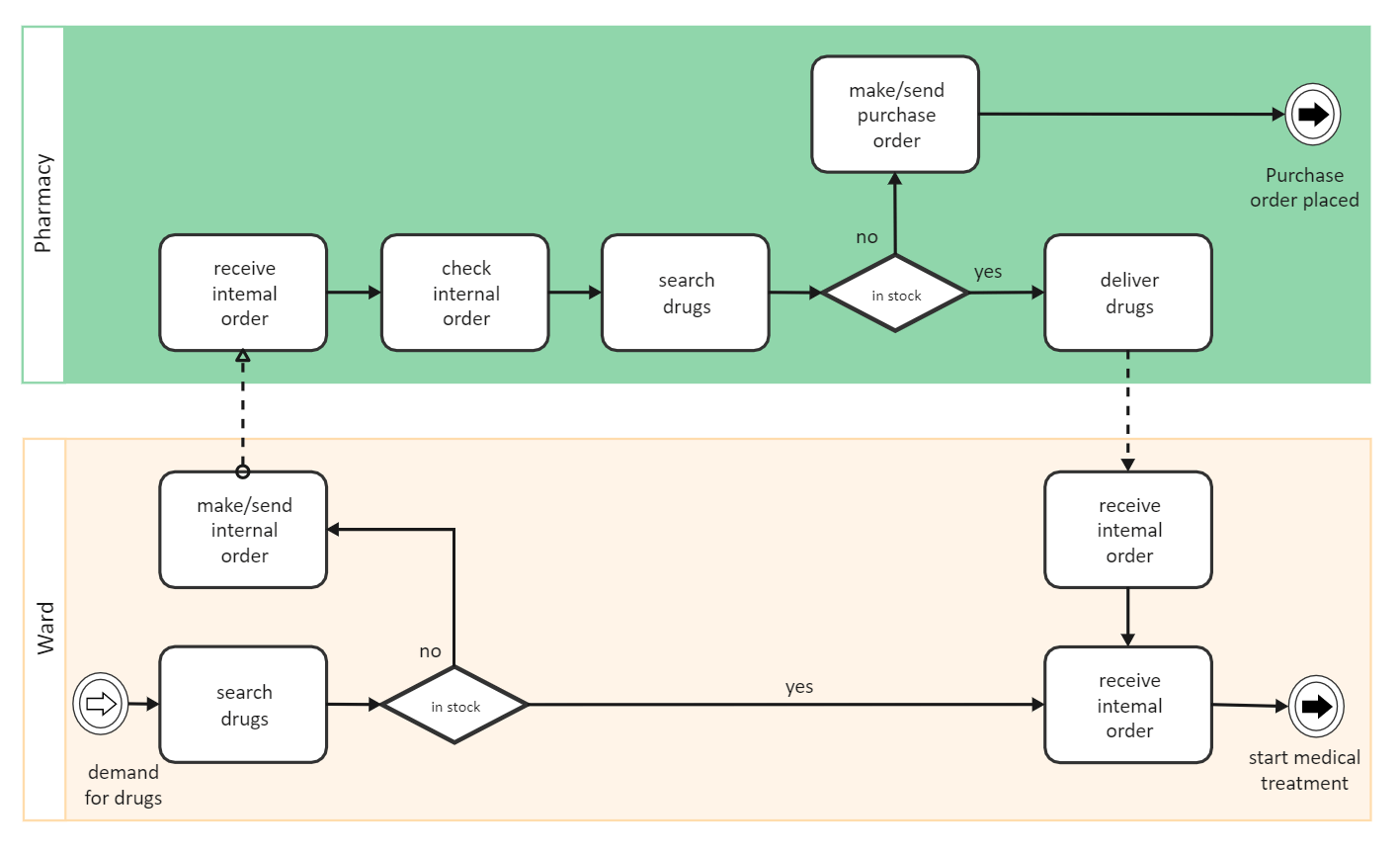
Example 6: Booking System
Let's look into the Booking system process modeling diagram; here, complete steps are mapped out for travelers from booking a ticket to the boarding process. The customer first reserves a ticket via a travel agency; then, after submitting some documents, the agency prepares the ticket for the passenger. Once the ticket is ready and checked out, flight information and other details are shared.
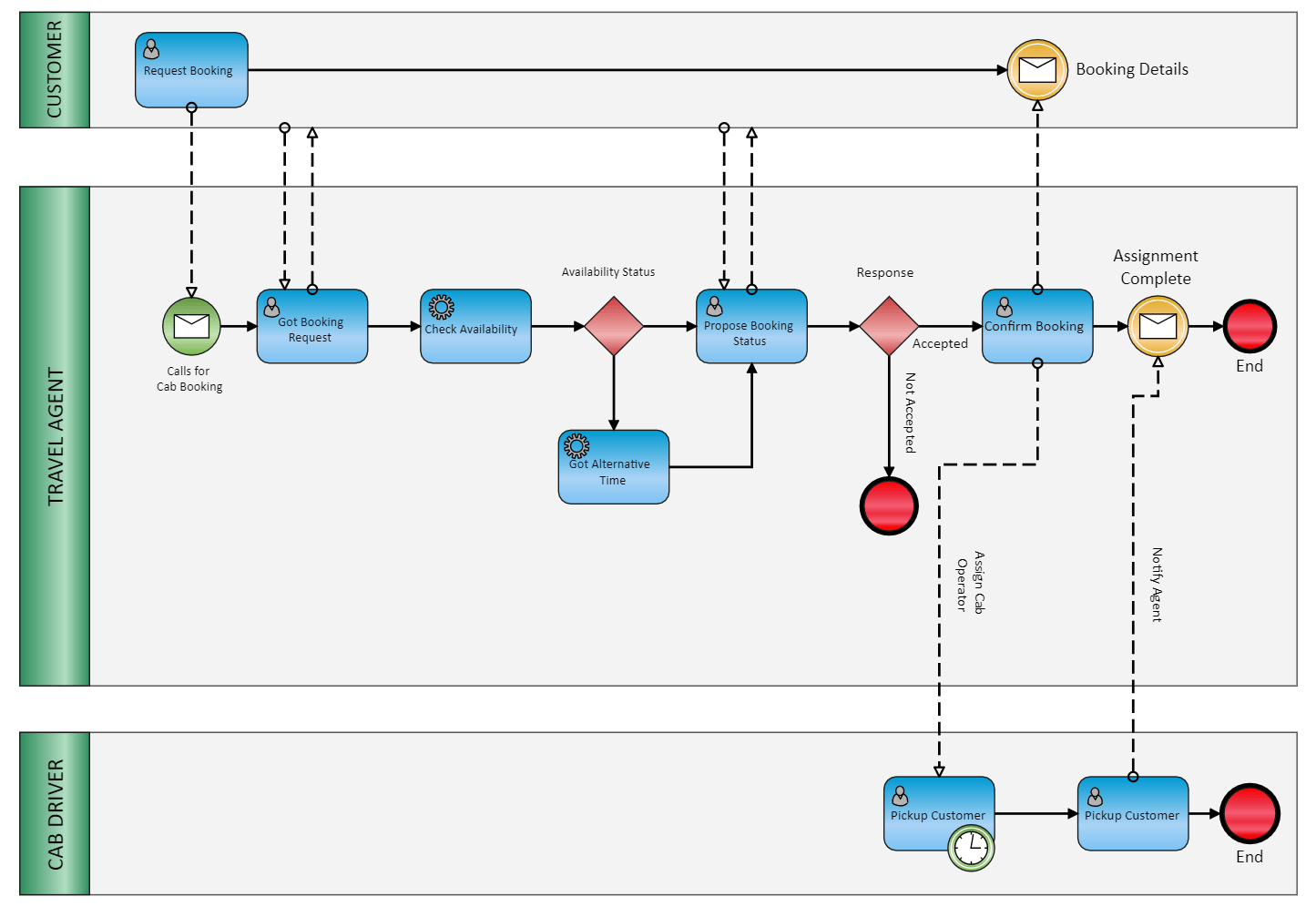
Example 7: HR
It is an example of the human resource management process; the recruitment process is mapped out here. When there is a need to recruit a new employee, an internal analysis is conducted, after which the company posts the job vacancy ad. When the people apply for the job, their resume evaluation is conducted, and ideal candidates are filtered out; then comes the Interview process, induction, and then the selected candidate is assigned job responsibilities. In the end, the training part comes where the candidate tasks are also evaluated to see if the candidate is fit for the position and if not, the company again posts a job vacancy.
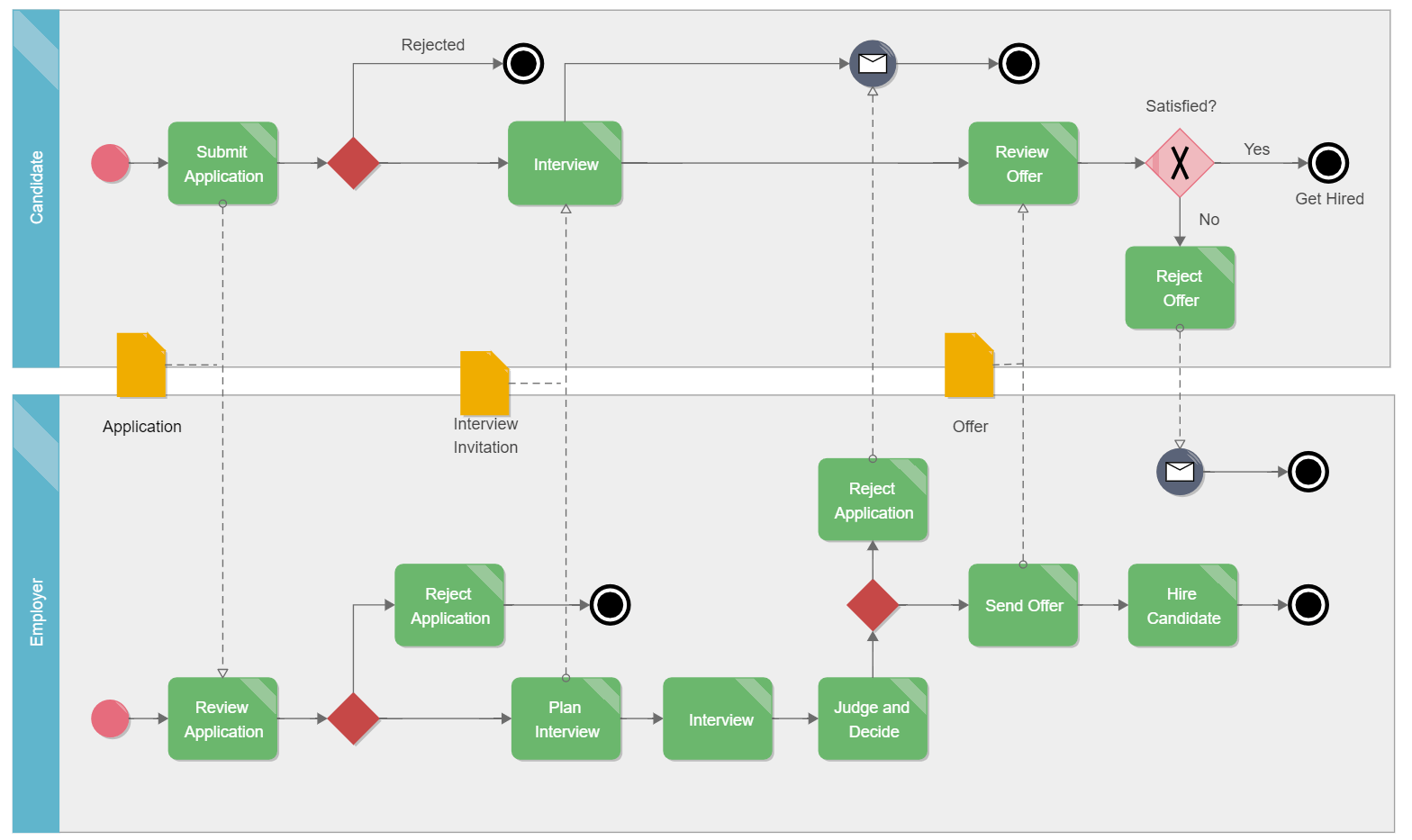
6. How to Create a BPMN Diagram?
We have explored multiple BPMN diagram examples and their applications in various fields now it's time to learn for creating a BPMN diagram.
1. Select the Right Diagram Type
The business process model comprises various types, including flowcharts, swimlane diagrams, git-flow diagrams, data flow charts, etc. Select an appropriate form of the process modeling diagram as per the requirements of the process of the activity.
2. Gather the Data
Identify the essential resources and information required to document a process and the steps, stages, participants involved in the process. Write down important deadlines, dates, and necessary solutions for the procedure. Do this part along with your whole team or at least with the main stakeholders of the process.
3. Create a Workflow
Once the data is analyzed and compiled, now design the workflow diagram, which will assist all stakeholders in understanding and working on the process.
4. Improving the Diagram
Once the diagram is designed, it's time to evaluate it. Look after every little detail of the process in parallel with the chart. With the help of your team, determine the crucial parts and important deadlines now, test the workflow diagram and check its functionality.
7. Several Tips for Business Process Modeling
Here are several quick tips on business process modeling.
- Display business details rather than implementation details.
- Use the form of ‘verb+noun’ to represent business processes such as ‘Register Customer.’
- Always indicate an end event.
- Use job roles/titles on swimlanes.
- Think of the reasons for modeling process flows.
8. Online BPMN Tool
So, after recognizing the importance of Business Process Modeling techniques, it is clear that we should also use the BPMN diagram to define our business processes graphically. For a simple drawing with pre-available templates, we highly recommend using EdrawMax BPMN software as it is a reliable and enriched software tool with great features.
